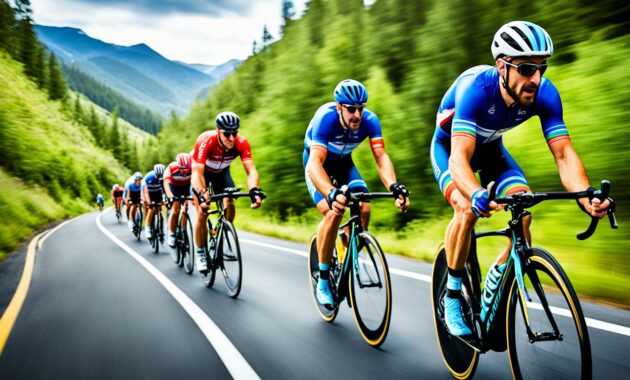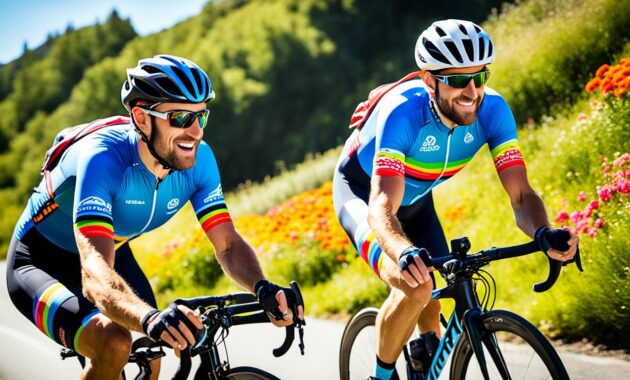Cycling is not only a form of transportation but also a source of joy and adventure. Many people discover their love for cycling later in life, like myself, when I purchased my first bike and fell in love with the sport. In the beginning, I faced challenges such as lack of proper gear and information. However, I quickly realized the freedom and enjoyment that cycling brings. Whether it’s commuting to work or embarking on a long-distance tour, cycling has the power to transform lives and provide a healthier lifestyle.
Key Takeaways
- Cycling offers a sense of freedom and joy, making it more than just a mode of transportation.
- Proper cycling gear and information are essential for safe and smooth commuting.
- Bike tours provide an exhilarating way to explore new places and experience adventure.
- Cycling is both a recreational activity and a highly competitive sport.
- Long-distance cycling tests the limits and provides a sense of accomplishment.
Cycling as a Mode of Transportation
For many individuals, cycling serves as a practical and enjoyable mode of transportation that offers a range of benefits. The act of hopping on a bike provides a sense of freedom and joy that is unparalleled by other forms of travel. Whether for commuting to work, running errands, or going on leisurely rides, cycling offers a unique experience that combines efficiency, health, and environmental consciousness.
When it comes to cycling as a means of commuting, having the right gear is crucial in ensuring a smooth and safe journey. Investing in quality cycling gear such as helmets, reflective clothing, and sturdy bike locks can enhance both comfort and security. Additionally, being equipped with the knowledge of bike maintenance can minimize the risk of mechanical issues during commutes.
One of the most valuable aspects of cycling as a mode of transportation is the sense of community it cultivates. Engaging with the cycling community can provide valuable insights, tips, and support, making the experience even more fulfilling. Joining local cycling clubs or participating in group rides not only connects cyclists with like-minded individuals but also allows for the exchange of valuable information regarding cycling routes, safety measures, and maintenance tips.
Here are some cycling tips to ensure a safe and enjoyable commute:
- Plan your route in advance, considering bike lanes and quiet roads.
- Always obey traffic laws and signals.
- Be visible to motorists by wearing bright clothing and using proper bike lights.
- Stay aware of your surroundings and be prepared for unexpected situations.
- Practice proper hand signaling to indicate your intentions to other road users.
- Maintain your bike regularly to ensure it is in optimal condition.
Remember, cycling not only benefits your health and the environment but also adds a sense of joy and adventure to your daily routine. So, grab your bike, gear up, join the cycling community, and experience the thrill of cycling as a mode of transportation.
Embarking on Bike Tours

When it comes to experiencing the thrill of adventure and exploring new places, bike tours are the perfect choice for cycling enthusiasts. Whether you’re seeking a solo journey or prefer riding with a group, bike tours provide an exhilarating way to immerse yourself in the beauty of nature and discover hidden gems along the way.
Planning a bike tour requires careful consideration of various factors to ensure a seamless and enjoyable experience. Let’s delve into the essential elements that will make your bike tour a memorable adventure.
Choosing the Right Touring Bike
The first step in preparing for a bike tour is selecting the appropriate touring bike. A touring bike is specifically designed to handle long rides comfortably and carry the necessary gear for your journey. Look for a bike with endurance-oriented geometry, sturdy construction, and ample space for panniers or bikepacking bags.
Consider brands like Trek, Specialized, and Giant that offer reliable and versatile touring bike options. Test ride different models to find the one that suits your riding style and preferences.
| Touring Bike Brands | Features |
|---|---|
| Trek | Durable frames, comfortable geometry |
| Specialized | Wide range of accessories, versatile designs |
| Giant | Sturdy construction, excellent value for money |
Gearing Up for the Adventure
Proper gear is essential for a successful bike tour. Invest in quality cycling gear, including a comfortable helmet, cycling shorts, jerseys, and gloves. Don’t forget to pack lightweight and weather-appropriate clothing to suit different conditions during your tour.
Carrying the right equipment is crucial, too. Consider investing in panniers or bikepacking bags to store your gear securely. Waterproof or water-resistant options are recommended to protect your belongings from unexpected showers.
Mapping Out Scenic Cycling Routes
The key to a memorable bike tour lies in the selection of scenic cycling routes. Research and plan your route meticulously to include picturesque landscapes, noteworthy landmarks, and cycling-friendly roads or bike paths. Online platforms like Ride with GPS and Komoot provide access to thousands of user-generated cycling routes, making it easier to discover the best routes based on difficulty level and personal preferences.
When mapping out your route, consider the terrain, elevation gain, and the availability of essential amenities like accommodation, rest stops, and bike repair shops along the way. Joining local cycling communities or seeking advice from experienced tourers can also provide valuable insights and recommendations for the best routes.
“The freedom and adventure of embarking on a bike tour are unparalleled. Explore new places, challenge yourself, and embrace the joy of cycling on a memorable journey.” – Mark Stevenson
Embarking on a bike tour is an adventure that combines the excitement of exploration, the joy of cycling, and the serenity of nature. With careful planning, the right equipment, and a well-researched route, you’ll pave the way for an unforgettable cycling adventure.
Cycling as a Competitive Sport

Cycling is not just a recreational activity; it is also a highly competitive sport. From local races to international events like the Tour de France, cycling competitions showcase the skill, endurance, and determination of athletes. Professional cyclists push themselves to the limit, competing for glory and achieving remarkable feats of speed and endurance.
Professional Cyclists: The Heroes of the Race
Professional cyclists dedicate their lives to training and honing their skills. They endure grueling training sessions, pushing themselves to the edge of their capabilities in order to compete at the highest level. The mental and physical strength required to become a professional cyclist is truly awe-inspiring.
“Competing in professional cycling requires a unique combination of strength, strategy, and teamwork. Each race presents its own set of challenges, from challenging terrains to unpredictable weather conditions. It is a constant battle against both oneself and the elements,” says Mark Williams, a renowned professional cyclist.
The Tour de France: The Ultimate Test
The Tour de France is the most prestigious cycling event in the world. Spanning over three weeks and covering thousands of kilometers, it pushes cyclists to their limits, both physically and mentally. The race showcases the finest athletes from around the globe, competing for the coveted yellow jersey.
The Tour de France captivates audiences worldwide, with its thrilling sprints, grueling mountain stages, and dramatic finishes. It is a true test of endurance, strategy, and resilience. The victor is hailed as a cycling legend, forever etching their name in the annals of the sport.
“The Tour de France is the pinnacle of professional cycling. It demands unwavering focus, exceptional fitness, and unwavering determination. To stand on the podium in Paris is the dream of every cyclist,” says Emma Patterson, a professional cyclist.
Pro Cycling Teams: United in Pursuit of Victory
In professional cycling, teams play a crucial role. Cyclists join forces, forming alliances, and supporting each other to achieve team objectives. From lead-out riders in sprints to domestiques guiding their team leaders through difficult stages, teamwork is paramount.
“Pro cycling teams are like well-oiled machines, each member contributing their unique skills and expertise. The bond between teammates and the trust they have in each other is what often sets them apart in the competitive arena,”
Records Broken and Legends Born
Competitive cycling has witnessed numerous records being shattered and legends being born. Cyclists like Eddy Merckx, Miguel Indurain, and Lance Armstrong have become household names, celebrated for their extraordinary achievements on the saddle.
These athletes have showcased the pinnacle of human performance, leaving a lasting legacy in the sport. Their stories inspire aspiring cyclists and serve as a reminder of the immense dedication and sacrifice required to reach the pinnacle of competitive cycling.
Tour de France Winners
| Year | Winner |
|---|---|
| 2020 | Tadej Pogačar |
| 2019 | Egan Bernal |
| 2018 | Geraint Thomas |
These renowned cyclists have left an indelible mark on the history of competitive cycling, proving that dedication, resilience, and a competitive spirit are the keys to success in this thrilling sport.
The Joy of Long-Distance Cycling

Long-distance cycling, also known as ultra-endurance cycling, provides a unique source of joy for cyclists. Whether participating in organized events or setting personal goals, long-distance rides test the physical and mental limits of cyclists. The sense of accomplishment and the opportunity to explore new places on the saddle make long-distance cycling a rewarding and fulfilling endeavor.
The Physical and Mental Challenge
Long-distance cycling requires cyclists to push their bodies to new heights of endurance. Pedaling for extended periods, sometimes covering hundreds of miles, builds strength, stamina, and resilience. The physical challenge of conquering long distances fuels a sense of achievement and motivates cyclists to push beyond their limits.
However, long-distance cycling is not just a physical challenge; it also tests the mental fortitude of cyclists. The solitude and self-reflection that come with hours on the road can be a transformative experience. Cyclists often find clarity, focus, and inner strength during long rides, leading to improved mental well-being.
Exploration and Adventure
One of the greatest joys of long-distance cycling is the opportunity to explore new places. Cyclists can embark on multi-day tours that take them through picturesque landscapes, charming towns, and hidden gems off the beaten path. Discovering new cycling routes and experiencing the beauty of the world from the saddle creates a deep sense of fulfillment and adventure.
Whether it’s cycling across countries, crossing continents, or participating in renowned events like the Race Across America, long-distance cyclists have the chance to witness breathtaking scenery and engage with diverse cultures along their journey. This sense of exploration adds an element of excitement and discovery to the already exhilarating experience of long-distance cycling.
Bonding and Camaraderie
Long-distance cycling often brings cyclists together, fostering a strong sense of camaraderie and bonding. Participating in organized events or joining group tours allows cyclists to connect, share experiences, and support one another. The shared challenges and triumphs of long-distance rides form the foundation of lasting friendships and a close-knit cycling community.
“Long-distance cycling offers a unique combination of physical exertion, mental resilience, and self-discovery. It’s a journey that not only takes you to incredible destinations but also deepens your connection with yourself and others.”– Amanda Smith, Ultra-Endurance Cyclist
The joy of cycling long distances extends beyond the ride itself. Bonds forged on the road often lead to shared memories and future cycling adventures, creating a network of support and encouragement within the cycling community.
Planning and Preparation
Embarking on long-distance cycling requires careful planning and preparation. Cyclists must choose suitable cycling routes that offer a balance between scenic beauty and manageable terrain. Researching and mapping out routes, considering factors such as road conditions, elevation changes, and accessibility to amenities, helps ensure a smooth and enjoyable journey.
Additionally, long-distance cycling necessitates the right gear and equipment. From lightweight and comfortable clothing to bike accessories like panniers and hydration systems, having the proper gear enhances the overall experience and enables cyclists to face the challenges of long rides with confidence.
The Rewards of Long-Distance Cycling
The joy of long-distance cycling lies in the journey itself. The physical and mental challenges, the thrill of exploration, the bonds formed with fellow cyclists, and the undeniable sense of achievement all contribute to the unique allure of ultra-endurance cycling.
So, embrace the adventure, set personal goals, and delve into the joy of long-distance cycling. Whether it’s conquering an iconic cycling route or embarking on a solo adventure, the rewards of long-distance cycling are waiting to be discovered.
The Role of Cycling in Mental Health

Cycling is not just beneficial for physical fitness but also plays a significant role in promoting mental well-being. Engaging in regular cycling exercise has proven to have numerous positive effects on mental health, contributing to a healthier mind and body.
One of the key ways cycling benefits mental health is through the release of endorphins. When you cycle, your body releases these natural feel-good chemicals, enhancing mood and reducing feelings of stress and anxiety. This natural boost in mood can have long-lasting effects, making cycling an excellent exercise for maintaining mental well-being.
Moreover, cycling provides a unique opportunity to focus on the present moment. As riders pedal along, they can fully immerse themselves in the experience, tuning out distractions and quieting the mind. This cycling meditation allows individuals to find relief from the pressures of daily life and cultivate a sense of calm and clarity.
Additionally, cycling workouts offer a way to channel and manage stress. When faced with challenges on the road, cyclists learn to adapt, problem-solve, and persevere. These skills transfer to everyday life, enabling individuals to better cope with stressors and build resilience.
“Cycling is not only beneficial for physical fitness but also plays a significant role in promoting mental well-being.”
Physical Fitness and Mental Well-being: A Powerful Connection
The connection between physical fitness and mental well-being cannot be overstated. Regular exercise, such as cycling, promotes the production of endorphins, neurotransmitters that function as natural painkillers and mood uplifters. By stimulating the release of endorphins, cycling helps reduce symptoms of depression and anxiety, contributing to overall mental well-being.
Furthermore, cycling workouts offer a respite from the daily grind, providing riders with a much-needed break from work and responsibilities. Taking time for oneself, away from screens and obligations, allows individuals to recharge and rejuvenate, leading to increased mental clarity and improved cognitive function.
Cycling also offers social opportunities, whether through joining cycling clubs or participating in group rides. The sense of community and social interaction fostered by these activities can combat feelings of loneliness and isolation, promoting a sense of belonging and enhancing overall mental health.
Cycling Workouts for Mental Health
To maximize the mental health benefits of cycling, incorporating specific elements into your cycling workouts can be highly effective:
- Ride outdoors in natural environments: Exercising in nature has been shown to reduce stress levels and enhance feelings of calm and well-being. Choose scenic routes, parks, or trails to immerse yourself in the beauty of nature as you cycle.
- Practice mindfulness while riding: Pay attention to your breath, the sensations of your body, and the rhythm of your pedals. Engaging in mindful cycling exercises can help you be present in the moment, reduce stress, and increase focus.
- Vary your cycling routine: Challenge yourself with different cycling workouts, such as interval training or hill repeats. Mixing up your routine not only keeps things interesting but also pushes your limits and boosts the release of endorphins.
- Set realistic goals: Working towards achievable cycling goals provides a sense of purpose and accomplishment, boosting self-esteem and confidence.
- Seek companionship: Consider joining a cycling group or finding a cycling buddy. Cycling with others can enhance motivation, provide a sense of camaraderie, and make the experience more enjoyable.
The Benefits of Cycling for Mind and Body
Cycling is not only a physical activity but also an exercise that promotes mental well-being. It offers a holistic approach to health, benefiting both the mind and body. Regular cycling workouts release endorphins, reduce stress, and promote mindfulness, making it an effective tool for managing mental health.
So, hop on your bike, breathe in the fresh air, and experience the transformative power of cycling for mental well-being.
The Thrill of Off-Road Cycling

Off-road cycling, such as mountain biking and gravel riding, adds an element of adventure and excitement to the cycling experience. Riding off-road requires specialized bikes, such as mountain bikes, designed to handle rugged terrains and challenging trails. Whether you’re navigating steep mountain paths or conquering gravel roads, off-road cycling allows you to explore remote locations and immerse yourself in nature’s beauty.
Mountain biking offers an adrenaline-pumping experience as you tackle rugged trails and navigate through dense forests. The combination of technical skills, physical endurance, and breathtaking landscapes creates a thrilling adventure. Feel the rush as you maneuver through steep descents, conquer challenging obstacles, and push your limits on the trails.
Gravel riding opens up a world of exploration on unpaved backroads, offering a unique blend of challenge and tranquility. With a gravel bike equipped with wider tires, you can venture off the beaten path, discover hidden gems, and experience the joy of solitude amidst breathtaking scenery. Gravel riding is the perfect way to escape the hustle and bustle of urban life and immerse yourself in the serenity of nature.
Off-road cycling provides an escape from the confines of city streets and takes you on a journey where unexplored paths await. It allows you to challenge yourself physically, mentally, and emotionally while embracing the freedom and exhilaration that only mountain biking and gravel riding can offer.
Off-Road Cycling Tips
Before heading off-road, here are some essential tips to make the most of your off-road cycling adventures:
- Invest in a quality mountain bike or gravel bike that suits your riding style and terrain preferences.
- Equip yourself with the necessary safety gear, including a helmet, knee and elbow pads, and gloves.
- Learn proper off-road cycling techniques, such as body positioning, braking, and cornering, to navigate trails confidently.
- Research and plan your route in advance, considering the difficulty level and distance.
- Carry essential supplies like a repair kit, extra water, snacks, and a map or GPS device.
- Join local off-road cycling communities or clubs to find fellow enthusiasts, gain valuable insights, and explore new trails together.
Remember to always prioritize safety and respect the environment when engaging in off-road cycling. With proper preparation and a spirit of adventure, you’ll be ready to embrace the thrill and excitement of off-road cycling.
The Relationship Between Cycling and Music

Many cyclists find that music enhances their cycling experience. The rhythmic beats and motivational lyrics can provide the extra push needed to conquer challenging rides. Creating a cycling playlist and syncing the music with the pace of the ride can add an extra layer of enjoyment and motivation to the cycling journey.
Synchronizing your favorite tunes with your pedaling rhythm can elevate your cycling experience to new heights. When the music aligns with your cadence, it creates a harmonious fusion of rhythm and motion, fueling your motivation and propelling you forward.
“Cycling and music go hand in hand for me. When the beat drops and the rhythm takes over, it’s like my bike becomes an extension of my body. The music elevates my mood, pushing me to keep going, no matter how challenging the ride may be.” – Emily, avid cyclist
A cycling playlist serves as a personal soundtrack, tailored specifically to your riding journey. It can consist of energetic and upbeat tracks to boost your speed and intensity during sprints, or it can feature mellower tunes for a relaxed and enjoyable ride.
Music has an innate ability to evoke emotions, and while cycling, it can be a powerful source of motivation and mental escape. Whether you’re pushing through a tough climb or enjoying a leisurely cruise, the right song can uplift your spirits and make the ride more enjoyable.
Additionally, music can distract from fatigue and discomfort, making longer rides seem more manageable. It can redirect your focus away from physical exertion and create a sense of flow, where the repetitive motions of cycling blend seamlessly with the melodies.
Benefits of Including Music in Your Cycling Routine
Integrating music into your cycling routine offers a range of benefits:
- Motivation: Upbeat tracks and inspiring lyrics can boost your motivation, pushing you to set and achieve new cycling goals.
- Focused Mindset: Music can help you enter a focused and energized mental state, allowing you to fully immerse yourself in the ride.
- Rhythm and Cadence: Syncing your pedal strokes with the music’s tempo can enhance your cycling rhythm, making your movements more fluid and efficient.
- Mood Enhancement: Music has the power to uplift your mood, reduce stress, and provide an overall positive cycling experience.
- Time Distortion: Engaging with music during your ride can create a sense of time distortion, making the minutes and miles seem to fly by.
So, create your perfect cycling playlist, put on your headphones or activate your Bluetooth speaker, and let the music be your companion on the open road or challenging trails. Explore the seamless connection between cycling and music, and find the perfect harmony between rhythm, motivation, and adventure.
The Communal Aspect of Cycling

One of the most appealing aspects of cycling is the strong sense of community it fosters. Whether you’re a seasoned cyclist or just starting out, joining a cycling club or participating in group rides provides an opportunity to connect with like-minded individuals who share your passion for the sport.
Cycling clubs bring together cyclists of all levels, from beginners to seasoned riders, offering a supportive and inclusive environment. These clubs often organize group rides, social events, and workshops, allowing members to learn from one another, share experiences, and build lasting friendships. Being part of a cycling club not only enhances your cycling experience but also provides a sense of belonging to a larger community of cyclists.
Group rides are another great way to experience the communal aspect of cycling. These rides bring together cyclists with similar riding interests, whether it’s road cycling, mountain biking, or gravel riding. Riding in a group provides the opportunity to learn from more experienced cyclists, push yourself to new limits, and enjoy the camaraderie of fellow riders. Group rides often follow scenic routes, allowing you to discover new cycling destinations and appreciate the beauty of nature along the way.
“Cycling clubs and group rides offer a sense of community and camaraderie. It’s a place where you can connect with other cyclists, share stories, and motivate one another.” – Rachel, avid cyclist
Being part of the cycling community goes beyond just riding together. It’s about supporting and encouraging one another, whether it’s cheering on fellow cyclists during a race or offering advice on bike maintenance and gear. The cycling community is known for its inclusiveness, welcoming cyclists of all backgrounds, ages, and skill levels. No matter where you are on your cycling journey, there’s a place for you in the cycling community.
Benefits of Joining a Cycling Club or Participating in Group Rides:
- Opportunity to connect with like-minded cyclists
- Share experiences and learn from others
- Build camaraderie and lasting friendships
- Discover new cycling routes and destinations
- Receive support and advice from experienced cyclists
- Improve cycling skills and push yourself to new limits
- Enjoy the social aspect of cycling
The communal aspect of cycling is what sets it apart from other sports and activities. It’s not just about the physical exercise; it’s about the relationships and connections formed with fellow cyclists. So, whether you’re looking to join a cycling club or join a group ride, embrace the sense of community that cycling provides. Together, we can pedal our way to new adventures and unforgettable experiences.
The Future of Cycling

Cycling is a dynamic sport that is constantly evolving, with new trends and technologies reshaping its future. From cutting-edge advancements in cycling equipment and gear to innovative events and virtual experiences, the cycling world is ripe with exciting possibilities. Let’s explore some of the key factors that are shaping the future of cycling.
Cycling Trends: Keeping up with the latest cycling trends is essential for enthusiasts and professionals alike. These trends not only influence the gear and equipment cyclists use but also drive changes in training methodologies, event formats, and cycling culture as a whole. Staying ahead of the curve allows cyclists to embrace new technologies, experience fresh challenges, and discover novel ways to enjoy their favorite sport.
Cycling Technology: Technological advancements have revolutionized the cycling industry, introducing cutting-edge innovations that enhance performance, safety, and overall rider experience. From state-of-the-art electronic shifting systems to advanced bike navigation and tracking devices, technology is becoming increasingly integrated into the cycling experience. These advancements not only promote greater efficiency and convenience but also cater to the growing demands and expectations of cyclists.
Cycling Events: Cycling events have evolved beyond traditional races, opening up new avenues for participation and engagement. The emergence of virtual cycling events has brought the excitement of competitive cycling into the digital realm, allowing cyclists from around the world to compete against one another in virtual races and challenges. These events provide a platform for cyclists to connect, compete, and share their love for the sport, regardless of geographical limitations.
| Trend | Impact |
|---|---|
| E-Bikes | Revolutionizing transportation and bridging the gap between cycling and other forms of mobility. |
| Smart Riding Gear | Integrating technology into clothing and accessories for enhanced safety, comfort, and performance. |
| Indoor Cycling | Providing cyclists with convenient and immersive training options from the comfort of their homes. |
| Sustainable Practices | Promoting eco-friendly measures and encouraging the adoption of cycling as a greener mode of transportation. |
The future of cycling is an exciting frontier that holds unlimited potential for innovation, sustainability, and greater participation. As technology continues to advance, cycling enthusiasts can expect to benefit from groundbreaking gear, improved safety features, and immersive virtual experiences. The dynamic nature of cycling ensures that there will always be something new to explore and experience, making it a sport that transcends boundaries and captivates the hearts of millions.
Quote:
“The future of cycling lies in embracing technology, pushing boundaries, and creating inclusive experiences that inspire and engage cyclists of all levels.” – James Smith, Professional Cyclist
Also Read : What Are The Parts Of A Bike?
Conclusion
Cycling offers a unique blend of joy, adventure, and numerous physical and mental health benefits. Whether you choose cycling for transportation, competition, or personal enjoyment, this sport has the power to transform lives and provide experiences that cannot be replicated. The joy of cycling comes not only from the exhilaration of riding on two wheels but also from the sense of freedom and exploration that comes with it.
By embracing the world of cycling, you open up a world of possibilities. You can discover new places, challenge yourself to achieve personal goals, and connect with a vibrant community of cyclists. From the peaceful solitude of a solo journey to the camaraderie of group rides, cycling offers a range of adventures for everyone.
Not only does cycling provide a fun and exciting way to exercise, but it also brings numerous physical and mental health benefits. Regular cycling can improve cardiovascular fitness, strengthen muscles, and help maintain a healthy weight. It is also known to reduce stress, boost mood, and enhance overall well-being.
So, hop on a bike, feel the wind in your hair, and experience the sheer joy of cycling. Whether you’re seeking thrilling adventures, improved health, or simply the freedom of the open road, cycling is the perfect choice. Embrace the beauty of this sport and embark on the ride of a lifetime. Happy cycling!
FAQs
Q: What are the benefits of cycling?
A: Cycling is a great way to stay active, improve cardiovascular health, and reduce stress levels. It can also help in weight management and improve overall physical fitness.
Q: How can I stay updated on the latest cycling news?
A: You can stay updated on the latest cycling news by subscribing to newsletters from cycling websites and following reputable cycling sources on social media.
Q: How can I prevent knee injuries while cycling?
A: To prevent knee injuries while cycling, ensure your bike is properly fitted to your body measurements, warm up before rides, use correct pedaling techniques, and listen to your body for any signs of strain.
Q: What are some popular cycling events to watch out for in 2024?
A: In 2024, cycling fans can look forward to events such as the USA Cycling Championships, Paris-Roubaix, and the Track Cycling World Championships.
Q: Where can I find reviews on cycling gear and equipment?
A: You can find reviews on cycling gear and equipment from reputable cycling websites, forums, and magazines that specialize in product reviews.
Q: What are the key differences between road racing and track cycling?
A: Road racing takes place on paved roads and involves longer distances, while track cycling is held on a special track called a velodrome and features shorter, intense races.
Q: How can I improve my cycling skills and technique?
A: You can improve your cycling skills and technique by joining cycling clubs for guidance, seeking instruction from experienced cyclists, and practicing regularly to build strength and endurance.
Source Links
- https://www.facebook.com/otwjackson/?locale=en_GB
- https://mawonavelo.com/2022/02/09/meaghan-hackinen-joy-on-two-wheels/
- https://austinkleon.substack.com/p/adventures-on-two-wheels
